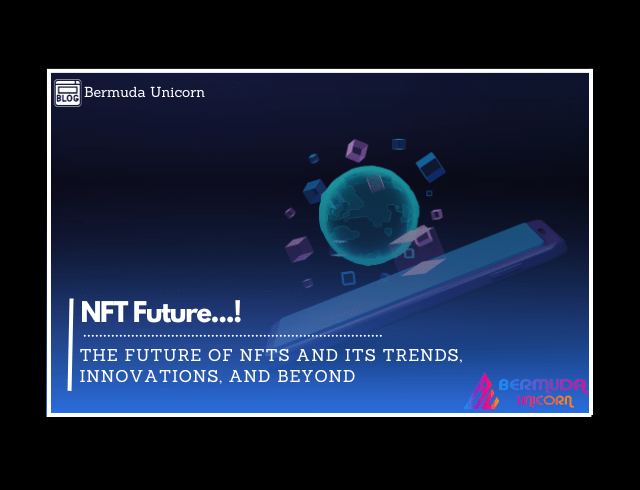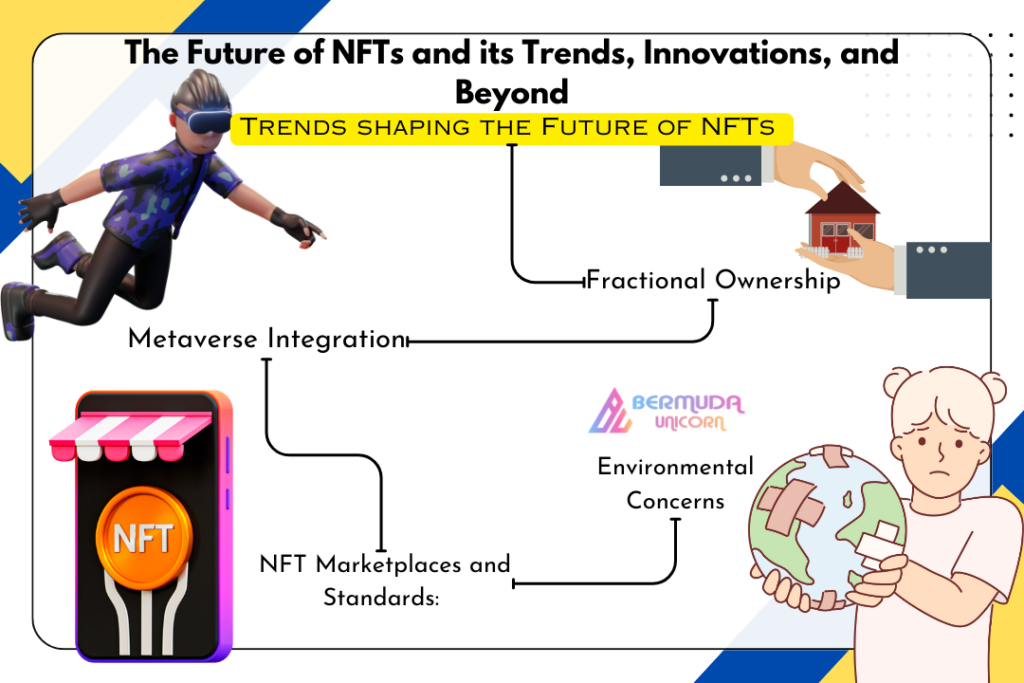![]()

Introduction
In recent times, Non-Fungible Tokens (NFTs) have garnered immense attention, fundamentally transforming our perception and trade of digital assets. NFTs have progressed beyond mere digital collectibles, emerging as a substantial influence in the realms of art, gaming, music, and diverse industries. As we look ahead to the future of NFTs, it’s evident that the journey is just beginning. In this blog, we will explore the latest trends, innovations, and what lies beyond the horizon for NFTs.
Trends Shaping the Future of NFTs
1. Metaverse Integration:
NFTs are making their way into the metaverse, creating opportunities for virtual ownership, digital fashion, and unique in-game items. As metaverse platforms like Beun1verse, Decentraland, and The Sandbox grow, NFTs will play a pivotal role in shaping the virtual world’s economy.
2. Fractional Ownership:
Fractionalized NFT ownership is gaining traction, allowing multiple investors to collectively own high-value NFTs. Also, this democratizes access to exclusive digital assets, making them more accessible to a broader audience.

3. NFT Marketplaces and Standards:
NFT marketplaces continue to proliferate, each offering unique features and curation. However, interoperability and standardization efforts will be essential for a more fluid NFT ecosystem. Projects like ERC-721 and ERC-1155 are steps in this direction.
4. Environmental Concerns:
With the increasing adoption of NFTs comes scrutiny regarding their environmental impact. Innovations like proof-of-stake blockchains and carbon-offsetting solutions are emerging to address these concerns.
Innovations Shaping the Future of NFTs
1. Dynamic NFTs:
Future NFTs may not be static images or files but dynamic assets that can change over time or respond to external stimuli. Also, this could unlock new possibilities for interactive art and adaptive in-game items.
2. NFTs in Real Estate:
The real estate industry is exploring NFTs for property ownership, reducing the complexity of property transactions and making real estate investment more accessible.
3. Augmented Reality Integration:
NFTs could find their way into augmented reality (AR) experiences, allowing users to interact with digital assets in the real world. Also, imagine exploring an AR museum filled with NFT art pieces.
4. NFT Identity and Authentication:
NFTs could become a crucial component of digital identity, enabling secure and verifiable online identities and credentials.
Beyond the Horizon: What’s Next for NFTs
1. Cross-Industry Integration:
NFTs will continue to blur the lines between various industries, creating new opportunities for artists, musicians, game developers, and even brands to engage with their audiences through unique digital assets.
2. Blockchain Advancements:
As blockchain technology evolves, NFTs will become more scalable, efficient, and eco-friendly, further driving their adoption.

3. Regulatory Frameworks:
Governments are beginning to establish regulations for NFTs and the broader crypto space. These regulations could provide more clarity and legitimacy to the NFT market.
4. Global Cultural Impact:
NFTs are already influencing culture, and their impact will only grow. Also, they may redefine concepts of ownership, copyright, and artistry in the digital age.
Frequently Asked Questions (FAQs)
1. What is the difference between NFTs and cryptocurrencies like Bitcoin?
– NFTs represent ownership of unique digital assets, while cryptocurrencies like Bitcoin are fungible. Also, primarily used as a digital store of value or medium of exchange.
2. Are NFTs a bubble, and is it too late to invest in them?
– While NFTs have seen significant growth, their long-term viability depends on their utility and adoption in various industries. Also, it’s not too late to invest, but thorough research is crucial.
3. How can I create and sell my own NFTs?
– To create and sell NFTs, you’ll need to choose a blockchain platform, and create a digital wallet. Also, mint your NFTs, and list them on an NFT marketplace like Bermuda Unicorn or Others.
4. Are NFTs environmentally friendly?
– Some NFTs, especially those on energy-efficient blockchains like Ethereum 2.0, have a lower carbon footprint. However, the environmental impact varies, so it’s essential to research the blockchain’s sustainability.
5. Can NFTs be stolen or counterfeited?
– NFTs are secured by blockchain technology, making it extremely difficult to steal or counterfeit them. However, scams can occur in the NFT space. Also, it’s essential to use reputable marketplaces and be cautious.
Conclusion
The future of NFTs holds promise and intrigue. As these digital assets continue to evolve, they will reshape how we perceive ownership, creativity, and authenticity in the digital realm. With ongoing innovations and cross-industry integration. Also, NFTs are poised to become a fundamental part of the digital economy, leaving an indelible mark on our culture and society. Whether you’re an artist, collector, investor, or simply curious, the journey into the world of NFTs promises to be an exciting one.
